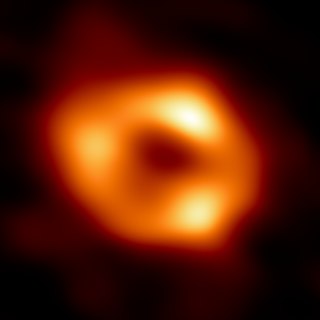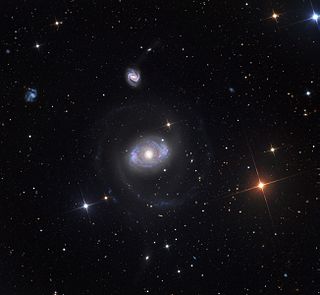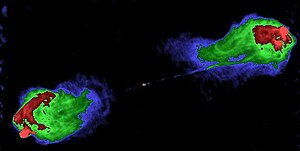
A quasar is an extremely luminous active galactic nucleus (AGN). It is sometimes known as a quasi-stellar object, abbreviated QSO. The emission from an AGN is powered by a supermassive black hole with a mass ranging from millions to tens of billions of solar masses, surrounded by a gaseous accretion disc. Gas in the disc falling towards the black hole heats up because of friction and releases energy in the form of electromagnetic radiation. The radiant energy of quasars is enormous; the most powerful quasars have luminosities thousands of times greater than that of a galaxy such as the Milky Way. Usually, quasars are categorized as a subclass of the more general category of AGN. The redshifts of quasars are of cosmological origin.
An active galactic nucleus (AGN) is a compact region at the center of a galaxy that has a much-higher-than-normal luminosity over at least some portion of the electromagnetic spectrum with characteristics indicating that the luminosity is not produced by stars. Such excess, non-stellar emissions have been observed in the radio, microwave, infrared, optical, ultra-violet, X-ray and gamma ray wavebands. A galaxy hosting an AGN is called an active galaxy. The non-stellar radiation from an AGN is theorized to result from the accretion of matter by a supermassive black hole at the center of its host galaxy.

3C 273 is a quasar located at the center of a giant elliptical galaxy in the constellation of Virgo. It was the first quasar ever to be identified and is the visually brightest quasar in the sky as seen from Earth, with an apparent visual magnitude of 12.9. The derived distance to this object is 749 megaparsecs. The mass of its central supermassive black hole is approximately 886 million times the mass of the Sun.

Seyfert galaxies are one of the two largest groups of active galaxies, along with quasars. They have quasar-like nuclei with very high surface brightnesses whose spectra reveal strong, high-ionisation emission lines, but unlike quasars, their host galaxies are clearly detectable.

A supermassive black hole is the largest type of black hole, with its mass being on the order of hundreds of thousands, or millions to billions of times the mass of the Sun (M☉). Black holes are a class of astronomical objects that have undergone gravitational collapse, leaving behind spheroidal regions of space from which nothing can escape, not even light. Observational evidence indicates that almost every large galaxy has a supermassive black hole at its center. For example, the Milky Way galaxy has a supermassive black hole at its center, corresponding to the radio source Sagittarius A*. Accretion of interstellar gas onto supermassive black holes is the process responsible for powering active galactic nuclei (AGNs) and quasars.

A blazar is an active galactic nucleus (AGN) with a relativistic jet directed very nearly towards an observer. Relativistic beaming of electromagnetic radiation from the jet makes blazars appear much brighter than they would be if the jet were pointed in a direction away from Earth. Blazars are powerful sources of emission across the electromagnetic spectrum and are observed to be sources of high-energy gamma ray photons. Blazars are highly variable sources, often undergoing rapid and dramatic fluctuations in brightness on short timescales. Some blazar jets exhibit apparent superluminal motion, another consequence of material in the jet traveling toward the observer at nearly the speed of light.

Sagittarius A*, abbreviated Sgr A*, is the supermassive black hole at the Galactic Center of the Milky Way. It is located near the border of the constellations Sagittarius and Scorpius, about 5.6° south of the ecliptic, visually close to the Butterfly Cluster (M6) and Lambda Scorpii.

The Sombrero Galaxy (also known as Messier Object 104, M104 or NGC 4594) is a peculiar galaxy of unclear classification in the constellation borders of Virgo and Corvus, being about 9.55 megaparsecs (31.1 million light-years) from the Milky Way galaxy. It is a member of the Virgo II Groups, a series of galaxies and galaxy clusters strung out from the southern edge of the Virgo Supercluster. It has a D25 isophotal diameter of approximately 29.09 kiloparsecs (94,900 light-years), making it slightly bigger in size than the Milky Way.

3C75 is a binary black hole system in the Abell 400 cluster of galaxies. It has four radio jets. It is travelling at 1200 kilometers per second through the cluster plasma, causing the jets to be swept back. The binary supermassive black holes are themselves contained in the dumbbell shaped galaxy NGC 1128. 3C 75 may be X-ray source 2A 0252+060.

APM 08279+5255 is a very distant, broad absorption line quasar located in the constellation Lynx. It is magnified and split into multiple images by the gravitational lensing effect of a foreground galaxy through which its light passes. It appears to be a giant elliptical galaxy with a supermassive black hole and associated accretion disk. It possesses large regions of hot dust and molecular gas, as well as regions with starburst activity.

NGC 4151 is an intermediate spiral Seyfert galaxy with weak inner ring structure located 15.8 megaparsecs from Earth in the constellation Canes Venatici. The galaxy was first mentioned by William Herschel on March 17, 1787; it was one of the six Seyfert galaxies described in the paper which defined the term. It is one of the nearest galaxies to Earth to contain an actively growing supermassive black hole. The black hole would have a mass on the order of 2.5 million to 30 million solar masses. It was speculated that the nucleus may host a binary black hole, with about 40 million and about 10 million solar masses respectively, orbiting with a 15.8-year period. This is, however, still a matter of active debate.

NGC 6251 is an active supergiant elliptical radio galaxy in the constellation Ursa Minor, and is more than 340 million light-years away from Earth. The galaxy has a Seyfert 2 active galactic nucleus, and is one of the most extreme examples of a Seyfert galaxy. This galaxy may be associated with gamma-ray source 3EG J1621+8203, which has high-energy gamma-ray emission. It is also noted for its one-sided radio jet—one of the brightest known—discovered in 1977. The supermassive black hole at the core has a mass of (5.9±2.0)×108 M☉.
The Event Horizon Telescope (EHT) is a large telescope array consisting of a global network of radio telescopes. The EHT project combines data from several very-long-baseline interferometry (VLBI) stations around Earth, which form a combined array with an angular resolution sufficient to observe objects the size of a supermassive black hole's event horizon. The project's observational targets include the two black holes with the largest angular diameter as observed from Earth: the black hole at the center of the supergiant elliptical galaxy Messier 87, and Sagittarius A* at the center of the Milky Way.

1E1740.7-2942, or the Great Annihilator, is a Milky Way microquasar, located near the Galactic Center on the sky. It likely consists of a black hole and a companion star. It is one of the brightest X-ray sources in the region around the Galactic Center.

NGC 708 is an elliptical galaxy located 240 million light-years away in the constellation Andromeda and was discovered by astronomer William Herschel on September 21, 1786. It is classified as a cD galaxy and is the brightest member of Abell 262. NGC 708 is a weak FR I radio galaxy and is also classified as a type 2 Seyfert galaxy.

NGC 541 is a lenticular galaxy located in the constellation Cetus. It is located at a distance of circa 230 million light years from Earth, which, given its apparent dimensions, means that NGC 541 is about 130,000 light years across. It was discovered by Heinrich d'Arrest on October 30, 1864. It is a member of the Abell 194 galaxy cluster and is included in the Atlas of Peculiar Galaxies in the category galaxies with nearby fragments. NGC 541 is a radio galaxy of Fanaroff-Riley class I, also known as 3C 40A.

Alcyoneus is a low-excitation, Fanaroff–Riley class II radio galaxy located 3.5 billion light-years (1.1 Gpc) away from Earth, corresponding to the galaxy SDSS J081421.68+522410.0. It is located in the constellation Lynx and it was discovered in Low-Frequency Array (LOFAR) data by a team of astronomers led by Martijn Oei. It has the largest extent of any radio galaxy identified, with lobed structures spanning 5 megaparsecs across, described by its discoverers as the "largest known structure of galactic origin." For comparison, another similarly sized giant radio galaxy is 3C 236, with lobes 15 million light-years across.















